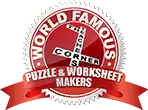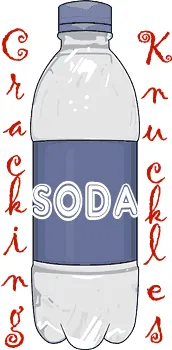 The Teacher's Corner
The Teacher's Corner
Puzzles and Activities
This week's experiment is a result of all the hours I spent with my camera this week. After long stretches of holding the camera, I was flexing my fingers and got some pretty loud pops. That got me thinking about what actually causes the cracking sound.
 To explore that, you will need:
To explore that, you will need:
First, you may want to try popping your knuckles. To do that, spread the fingers on both hands. Put your hands palm to palm. Slide one hand slightly to the side, so that your fingers can slide forward, interlocking. Move your wrists apart and turn your hands so that your palms face away from you, still keeping your fingers interlocked. Gently push your hands away from you. If your knuckles are going to pop, you will hear the sound. Be gentle. You are not trying to break or dislocate your fingers. If you don't get a pop, then wait a while and try again. Not everyone can pop their knuckles, so don't hurt yourself by trying too hard.
Some of you may be worried about popping your knuckles. Several studies have been done, and there are no indications that it causes arthritis. You should know that popping your knuckles frequently can cause damage to the soft tissues of your joint, but doing it just for this experiment should not cause any injuries.
What causes that popping sound? Inside the joint, there is a small sack filled with liquid called the sinovial fluid. This fluid lubricates the joint, so that it slides easily. When you stretch the joint, you also stretch the sack, making it larger. That creates a lowered pressure in the sinovial fluid, which causes gases dissolved in the fluid to come out. The rapid expansion of this gas bubble causes the sound.
By now, you are probably wondering about gases being dissolved in liquid, and about how a change in pressure can cause them to come out of solution. A very easy way to see that is with a bottle of carbonated soda. While the bottle is closed, the contents are under pressure. If you open the bottle, you lower that pressure, and the carbon dioxide gas that is dissolved in the soda begins to come out. That is what makes the foam and fizz of the soda.
Once you have formed the gas bubble in your joint, it usually takes 20 to 30 minutes for it to redissolve. That is why you can't pop your knuckles over and over. If you feel the need to try the experiment again, relax and drink the soda while you wait.
There are other ways for your joints to pop. Tendons are the string-like tissue that connects muscles to bones. If your tendons are tight, then as you bend the joint the tendon may slip to the side and then pop back into place. Arthritis can also cause joints to make noise, as the bone scrapes against bone. Hopefully, you won't have to experience that. In the mean time, add some ice cream to that soda and enjoy yourself.
Have a wonder filled week.
 Check out more Fun experiments for kids
Check out more Fun experiments for kids
All lessons are brought to you by The Teacher's Corner and Robert Krampf's Science Education Company.
Robert Krampf's Science Shows thehappyscientist.com